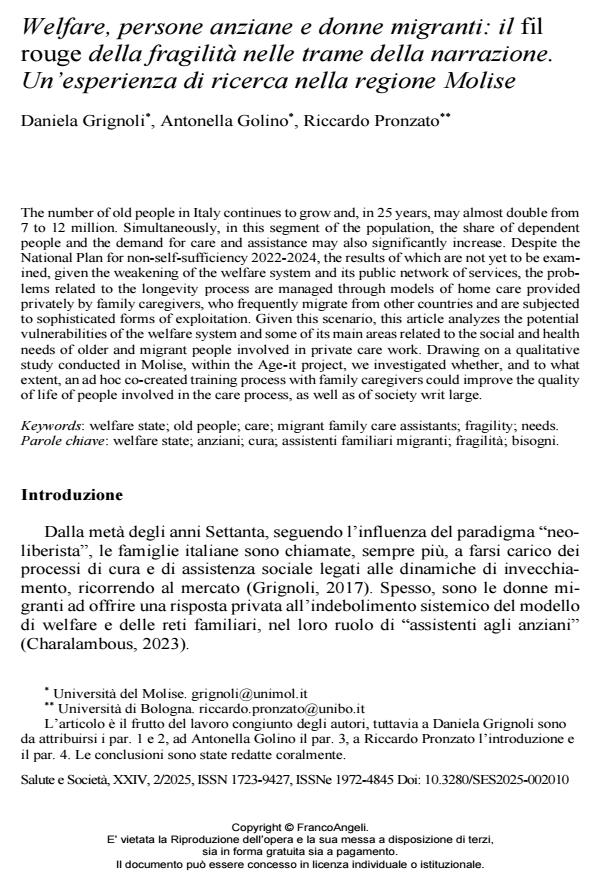Welfare, persone anziane e donne migranti: il fil rouge della fragilità nelle trame della narrazione. Un’esperienza di ricerca nella regione Molise
Journal title SALUTE E SOCIETÀ
Author/s Daniela Grignoli, Antonella Golino, Riccardo Pronzato
Publishing Year 2025 Issue 2025/2
Language Italian Pages 11 P. 118-128 File size 380 KB
DOI 10.3280/SES2025-002010
DOI is like a bar code for intellectual property: to have more infomation
click here
Below, you can see the article first page
If you want to buy this article in PDF format, you can do it, following the instructions to buy download credits

FrancoAngeli is member of Publishers International Linking Association, Inc (PILA), a not-for-profit association which run the CrossRef service enabling links to and from online scholarly content.
The number of old people in Italy continues to grow and, in 25 years, may almost double from 7 to 12 million. Simultaneously, in this segment of the population, the share of dependent people and the demand for care and assistance may also significantly increase. Despite the National Plan for non-self-sufficiency 2022-2024, the results of which are not yet to be examined, given the weakening of the welfare system and its public network of services, the problems related to the longevity process are managed through models of home care provided privately by family caregivers, who frequently migrate from other countries and are subjected to sophisticated forms of exploitation. Given this scenario, this article analyzes the potential vulnerabilities of the welfare system and some of its main areas related to the social and health needs of older and migrant people involved in private care work. Drawing on a qualitative study conducted in Molise, within the Age-it project, we investigated whether, and to what extent, an ad hoc co-created training process with family caregivers could improve the quality of life of people involved in the care process, as well as of society writ large.
Keywords: welfare state; old people; care; migrant family care assistants; fragility; needs.
- Urbanski M. (2022). Comparing push and pull factors affecting migration. Economies 10(1): 21.
- Vignoli D., Barbi E., Paterno A. (2024). La demografia dell’invecchiamento: una lettura positiva. Il Mulino, 73(4): 12-30. DOI: 10.1402/11495
- Ambrosini M. (2013). Migrazioni irregolari e welfare invisibile. Bologna: Il Mulino.
- Charalambous A. (2023). Informal Caregivers: From Hidden Heroes to Integral Part of Care. Cham: Springer.
- Crenshaw K. (2017). On Intersectionality: Essential Writings. New York: The New Press.
- Ehrenreich B., Hochschild A.R., a cura di (2004). Donne globali: tate, colf e badanti. Milano: Feltrinelli Editore.
- Grignoli D. (2017). Welfare e percorsi di innovazione. In: Barba D., Grignoli D., a cura di, Welfare Rights e Community Care. Rischi e opportunità del vivere sociale. Napoli: Edizioni Scientifiche Italiane.
- INPS (2024). Rapporto su lavoratori domestici. Testo disponibile al sito: https://servizi2.inps.it/servizi/osservatoristatistici/api/getAllegato/?idAllegato=1013 (08/04/2025).
- Istat (2019). Annuario statistico italiano 2019. Roma: Istat. Testo disponibile al sito: https://www.istat.it/produzione-editoriale/annuario-statistico-italiano-2019/ (08/04/2025).
- Istat (2023). Rapporto annuale 2023. La situazione del Paese. Roma: Istat. Testo disponibile al sito: https://www.istat.it/storage/rapporto-annuale/2023/Rapporto-Annuale-2023.pdf (08/04/2025).
- Istat (2024). Previsioni della popolazione residente e delle famiglie. Roma: Istat. Testo disponibile al sito: https://www.istat.it/wp-content/uploads/2024/07/Previsioni-popolazione-famiglie_2023.pdf (08/04/2025).
- Lowenstein A. (2007). Solidarity-conflict and ambivalence: testing two conceptual frameworks and their impact on quality of life for older family members. Journals of Gerontology: psychological sciences and social sciences, 62B: 100-107.
- Melchiorre M.G., Quattrini S., Lamura G., Socci M. (2021). A mixed-methods analysis of care arrangements of older people with limited physical abilities living alone in Italy. International Journal of Environmental Research and Public Health, 18(24): 12996.
- Pavolini E., Sabatinelli S., Vesan P. (2021). I servizi di welfare in Italia alla prova della pandemia. Uno sguardo di insieme. Social Policies, 8(2): 211-232. DOI: 10.7389/10167
- Reyneri E. (2017). Introduzione alla sociologia del mercato del lavoro. Bologna: Il Mulino.
- Ricolfi L. (2011). La Repubblica delle tasse. Perché l’Italia non cresce più. Milano: Rizzoli.
- Ritchie J., Lewis J., McNaughton Nicholls C., Ormston R., a cura di (2013). Qualitative Research Practice. A Guide for Social Science Students and Researchers. Thousand Oaks: Sage.
- Santini S., Finco M., Galassi F. (2022). Education and Employment of Refugees and Migrants in the Formal Elderly Healthcare Sector: Results from an Online Survey in Italy. Sustainability, 14: 3540.
- Tomassini C., Albertini M., Lallo C., (2023). Avanzare insieme nella società anziana. Considerazioni multidisciplinari sulla domanda di assistenza agli anziani in Italia. Bologna: Il Mulino.
- Tur-Sinai A., Teti A., Rommel A., Hlebec V., Lamura G. (2020). How many older informal caregivers are there in Europe? Comparison of Estimates of their prevalcence from three European surveys. International Journal of Environmental Research and Public Health, 17(24): 9531.
Daniela Grignoli, Antonella Golino, Riccardo Pronzato, Welfare, persone anziane e donne migranti: il fil rouge della fragilità nelle trame della narrazione. Un’esperienza di ricerca nella regione Molise in "SALUTE E SOCIETÀ" 2/2025, pp 118-128, DOI: 10.3280/SES2025-002010